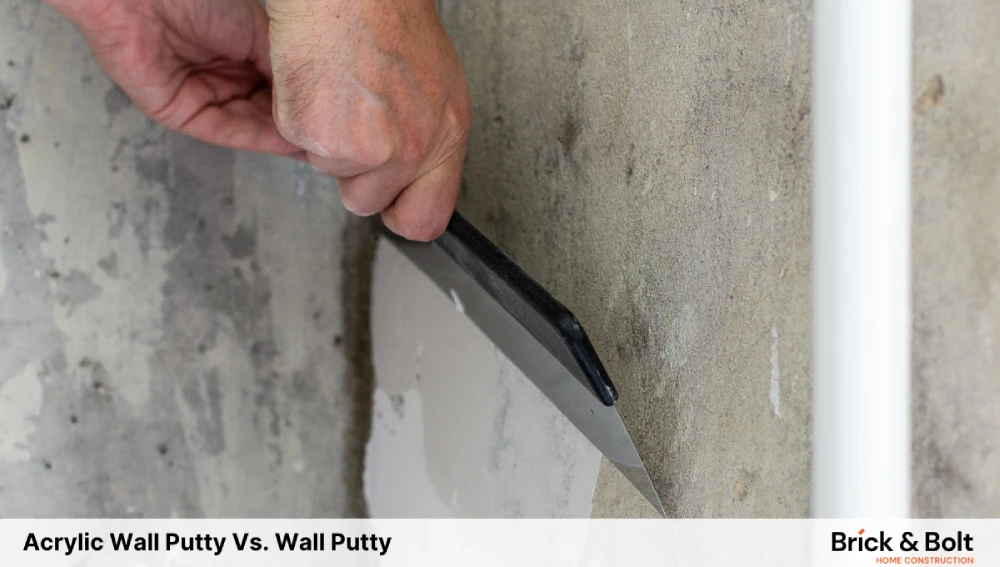Adding putty to your walls is a very important step when constructing a building. It gives your wall strength and durability and helps it remain damage-free for a longer period.
There are two types of wall putties you can choose from for your walls: acrylic wall putty and cement wall putty. Both of these are highly useful and have their own advantages and disadvantages. The trick here is to know when and where to use each of them.
In this article, we will learn all about these two types of putties and understand them clearly. This can help you choose between the two.
What is Acrylic Wall Putty?
Acrylic wall putty is a water-based, alkali-resistant putty made of acrylic materials. It is considerably more expensive than cement wall putty. However, it is more water resistant, gives a smoother finish, and has higher durability.
Acrylic wall putty can be used on both exterior and interior wall surfaces. It gives a smooth wall that can be painted on without any cracks or flakes.
One of the main advantages of acrylic wall putty is its drying time. It dries within a short period of 30 minutes and can be painted soon after.
What is Cement Wall Putty?
As the name implies, cement wall putty is made of cement. This is also applied to walls to give a smoother and longer-lasting finish that can be painted after drying.
Cement wall putty is commonly used in masonry wall surfaces and when there are huge gaps or cracks on walls. The putty is white in color, giving a clear and smooth canvas for painting.
Cement wall putty is water resistant and is good at preventing cracking and flaking.
Advantages And Disadvantages Of Acrylic Wall Putty
| Advantages | Disadvantages |
| Highly water resistant. Ideal for areas that get wet often, like bathrooms, kitchen, etc. | It can be more expensive than cement wall putty. |
| Provides a smooth and flawless finish. | It is not as strong as to be applied on big cracks or holes. |
| Dries very quickly, within 30 minutes. | —- |
| Bonds well with various surfaces like plaster and masonry. | —- |
| Suitable for both outdoor and indoor wall surfaces. | —- |
| Gives an even, shiny look after painting and extends the lifetime of the paint. | —- |
Advantages And Disadvantages Of Cement Wall Putty
| Advantages | Disadvantages |
| Less expensive than acrylic wall putty. A budget-friendly option. | Has lower water resistance and is not suitable for humid or wet areas. |
| It is very strong and durable and can be used to fill big cracks and holes. | Has a longer drying time of 4 to 6 hours. It is not suitable if you wish to quickly complete the process. |
| Easily available in most stores. | Most suitable for indoor wall surfaces. |
| Has a higher resistance to wear and tear. | Requires additional sanding for a smoother surface. |
Factors to Consider When Choosing Wall Putty For Your Home
As you can see, both acrylic and cement wall putty have their own advantages and disadvantages. So, how do you decide which one to use for your home?
Having some determining factors can help you with that. Below are some important factors to consider when choosing between acrylic and cement wall putties.
The type of surface
Both acrylic and cement wall putty work well on different types of wall surfaces. For example, both acrylic and cement wall putty can be used on plastered walls. However, for masonry and concrete walls, cement putty is often the best choice among the two.
Location
The location of usage plays an important role in the type of wall putty you can use. If your locality is highly prone to rain or your selected room easily gets wet, it is best to use acrylic wall putty as It is highly water-resistant and has a long life.
Budget
Acrylic wall putty can be more expensive than cement wall putty. If you want to lower the overall costs and go for a budget-friendly option, choose cement wall putty.
Desired finish
Acrylic wall putty can give you a smoother and flawless finish than cement wall putty. Cement putty is best for textured finishing but requires additional work. Choose the putty based on how you want the end product to look.
Drying time
If you are on a tight schedule and wish for quick work completion, acrylic putty is the best choice for you. It dries within 30 minutes of application. Cement wall putty takes about 4 to 6 hours to dry and is suitable for a strong and durable finish.
Quality
Whether you choose acrylic or cement wall putty, its quality is very important. Choose putties from a reputable brand with a good track record and customer satisfaction.
Conclusion
From the above article, you must have understood that both cement and acrylic wall putties have their own advantages and are best for use in certain areas.
Before choosing the wall putty for your home, consider the factors we discussed above and determine the purpose and area of application. You can also consult a professional and choose the right type of putty for your home.
FAQs
Acrylic wall putty is strong and durable, which makes it highly resistant to cracks and flakes. It is also water resistant, making it a good choice for application in areas where the walls can get easily wet.
Yes, wall putty can be used to fill cracks and holes on wall surfaces and give it an even and smooth finish. You can paint the wall and make it seem as if the crack was never there before.

